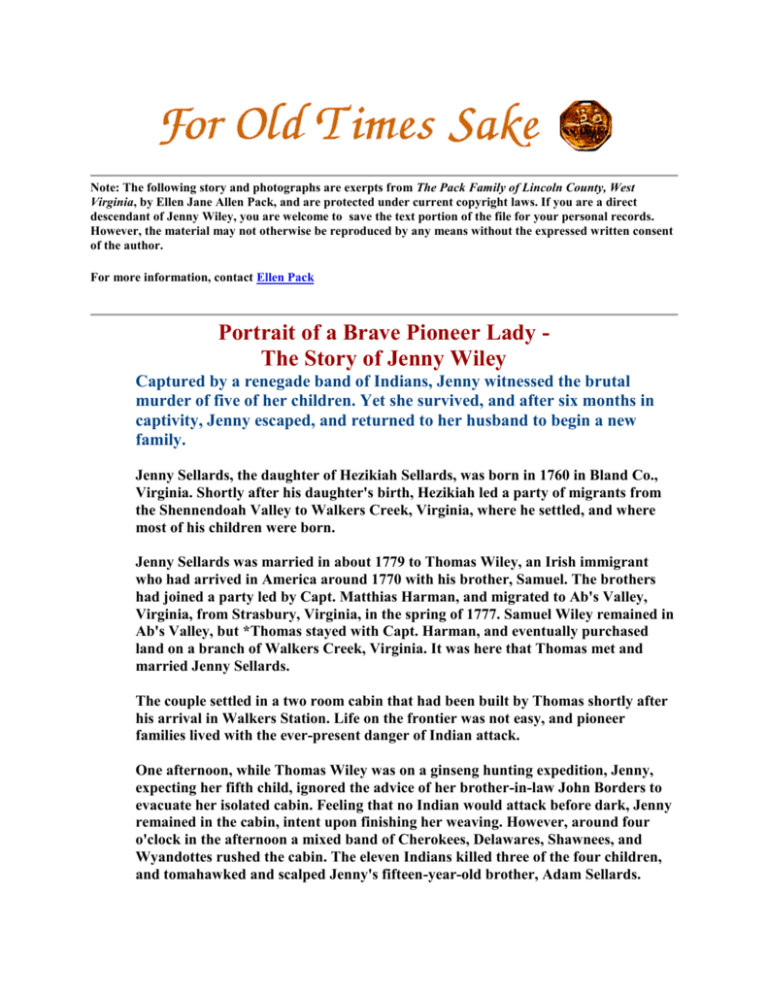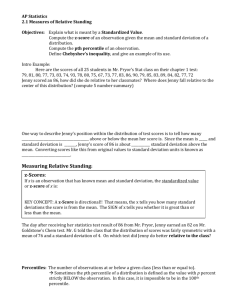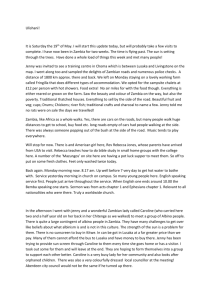Portrait of a Brave Pioneer Lady - The Story of
advertisement

Note: The following story and photographs are exerpts from The Pack Family of Lincoln County, West Virginia, by Ellen Jane Allen Pack, and are protected under current copyright laws. If you are a direct descendant of Jenny Wiley, you are welcome to save the text portion of the file for your personal records. However, the material may not otherwise be reproduced by any means without the expressed written consent of the author. For more information, contact Ellen Pack Portrait of a Brave Pioneer Lady The Story of Jenny Wiley Captured by a renegade band of Indians, Jenny witnessed the brutal murder of five of her children. Yet she survived, and after six months in captivity, Jenny escaped, and returned to her husband to begin a new family. Jenny Sellards, the daughter of Hezikiah Sellards, was born in 1760 in Bland Co., Virginia. Shortly after his daughter's birth, Hezikiah led a party of migrants from the Shennendoah Valley to Walkers Creek, Virginia, where he settled, and where most of his children were born. Jenny Sellards was married in about 1779 to Thomas Wiley, an Irish immigrant who had arrived in America around 1770 with his brother, Samuel. The brothers had joined a party led by Capt. Matthias Harman, and migrated to Ab's Valley, Virginia, from Strasbury, Virginia, in the spring of 1777. Samuel Wiley remained in Ab's Valley, but *Thomas stayed with Capt. Harman, and eventually purchased land on a branch of Walkers Creek, Virginia. It was here that Thomas met and married Jenny Sellards. The couple settled in a two room cabin that had been built by Thomas shortly after his arrival in Walkers Station. Life on the frontier was not easy, and pioneer families lived with the ever-present danger of Indian attack. One afternoon, while Thomas Wiley was on a ginseng hunting expedition, Jenny, expecting her fifth child, ignored the advice of her brother-in-law John Borders to evacuate her isolated cabin. Feeling that no Indian would attack before dark, Jenny remained in the cabin, intent upon finishing her weaving. However, around four o'clock in the afternoon a mixed band of Cherokees, Delawares, Shawnees, and Wyandottes rushed the cabin. The eleven Indians killed three of the four children, and tomahawked and scalped Jenny's fifteen-year-old brother, Adam Sellards. Jenny and her eighteen-month-old infant were taken captive, along with the Wiley hunting dog, Tige. The party traveled along an Indian trail that is today known as Jenny's Creek. It was along that trail that the Indians killed the infant. The party then crossed Bushy and Rich Mountains, and traveled north along the Tug and Big Sandy Rivers until they reached the Ohio River. Finding the river too swollen to cross, the Indians turned south. Eventually the party arrived at what is now called Cherokee Fork of the Big Blaine Creek, in Kentucky, where they made camp and stayed for several months. Upon learning of the atrocity, Thomas Wiley and a dozen settlers immediately set out in a rescue attempt. They were unsuccessful, as was Capt. Harman and a group of hunters that included Absalom Lusk, Henry and James Skaggs, Robert Hawes, Daniel Harman, Adam and Henry Harman, a man named Horn, and one named Leek, who attempted to track the party of Indians the next day. Finding the slain infant along the way, Harman and his men buried the child under a white oak tree before continuing their search. However, the party was forced to turn back upon reaching the swollen Louisa River. Capt. Harman did not stay in Walkers Creek. Instead, he returned to his blockhouse fort in present-day Johnson County, Kentucky, where, for the third time, he attempted to settle the area. Built in the winter of 1787-88, the block house was known as Harman's Station, and was the first settlement attempted in Eastern Kentucky. Jenny Wiley delivered her fifth child, while in captivity, a few months after her capture. She named the infant Robert Bruce Wiley. For a few weeks, the Indians were kind to Jenny, but killed the baby when he was three months old, because the infant "failed" a test of courage. Leaving Cherokee Fork, the Indians traveled to a cave located above Little Mud Lick Falls, in present-day Johnson County, Kentucky. At one point, the Indians decided to kill their captive, but Jenny's life was spared by an old chief, who decided he wanted to "purchase" Jenny for himself. Forced into hard labor, and bound when the Indians left the encampment, Jenny remained with the Indians for several more months. Finally, on a rainy morning, Jenny made her escape. Prior to leaving the encampment for a buffalo hunt, the Indians had bound Jenny's hands and feet with rawhide strips. Rolling out of the shelter into the rain, Jenny waited until the rawhide strips loosened to the point where she could free herself. Armed with a two day supply of meat, a scalping knife, and a tomahawk, Jenny set out on her perilous journey. She traveled south for several hours until she reached Little and Big Mud Lick Creeks. Jenny waded the creeks to the point where they flow into Big Paint Creek. The water was swift and deep. Nearly drowning in the swift current, Jenny grabbed a floating branch and allowed the current to carry her to the mouth of a stream that now bears her name, Jennies Creek. From there Jenny waded south until she reached a fork. Jenny took the left fork, then crossed a divide through a low gap, which led her to another stream. Jenny followed the stream to it's mouth, the Levisa Fork. Finding the river too deep to wade, Jenny rested until morning. Sunrise revealed that she was almost directly across from the blockhouse at Harman's Station. Jenny began shouting for help. The first man to hear her cries was Henry Skaggs. With the help of others, Henry Scaggs quickly fashioned a raft, using grapevine to lash together several logs, which he then paddled across the river. Jenny and her rescuer reached safety just as the old Indian chief appeared on the opposite side of the river. The chief called to Jenny, then turned and disappeared into the woods. The length of time that Jenny Sellards Wiley remained a captive of the renegade Indian party is in some dispute. Most renditions of the story chronicle an eleven month incarceration. However, a letter written to then Virginia Governor Randolph, by J. D. Smith, County Lieutenant of Russell County, Virginia, dated July 4, 1790, mentions Jenny's return as occurring in late winter. Presumably, then, Jenny was held captive for about six months. After a brief rest, Jenny was guided back to Walkers Creek, where she was reunited with her husband, Thomas Wiley. After her return, Jenny and Thomas began a new family. Five children were born after the captivity. Jenny (Sellards) and Thomas Wiley remained at Walker's Creek for about ten years. Around 1800, Jenny and Thomas relocated to Kentucky. They settled in an area on the banks of the Levisa Fork, of the Big Sandy, not far from the site of Jenny's rescue. The homestead became known as The Wiley Farm on Tom's Creek. Thomas Wiley died in 1810. He was buried on a small flat upon a hill about 150 feet above present-day Kentucky State Highway 581. Over the years, the marker disappeared, and eventually the ground was plowed under for a corn field, removing any trace of Thomas' grave. Jenny (Sellards) Wiley survived her husband by twenty-one years. In her later years, she lived with her son, William. Jenny (Sellards) Wiley passed away in 1831 of "paralysis," and is buried on a hill just down from the William's farm near the tiny community of River, Kentucky. The Wiley Farm was sold, in 1847, to James Nibert, who in turn sold it to Samuel Spears, in 1877. Original grave marker of Jenny Wiley, protected by iron bars. In 1965, the original hand-carved marker on Jenny’s grave was augmented by a large memorial stone. The inscription on the memorial stone reads: Jenny Wiley 1760-1831. Historic Pioneer Mother, Captured by Indians, October 1, 1789 at Walker's Creek, Virginia. Witnessed the slaying of her brother and five children by savages. Was held captive for several months on Little Mud Lick Creek in the present Johnson County. She escaped the Indians to Harman Station at Block House Bottom and was later united with her husband, Thomas Wiley, in Virginia. Mrs. Wiley returned to Johnson County with her husband and a cabin was built about the year 1800 where they reared five children. Jenny Wiley died in 1831. . . Similiar Sites: . Indian Captives of Early American Pioneers . Notable Women . . Return to The Jenny Wiley Trail . Return to The Jenny Wiley Cabin ..







